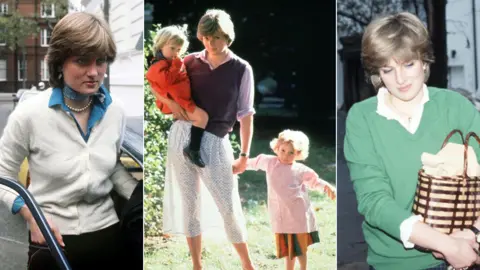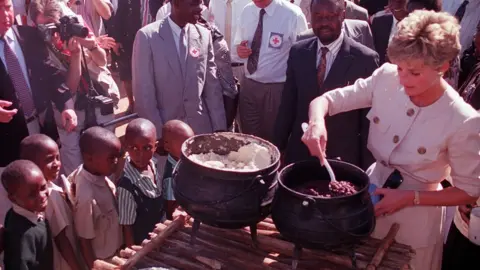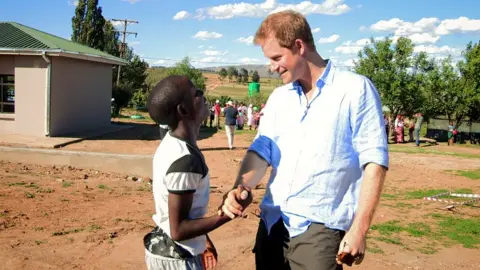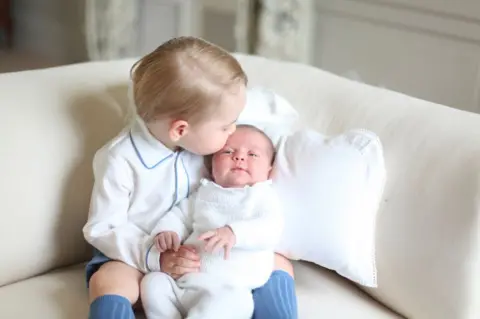Diana's embrace: The legacy she left her sons
 Getty Images
Getty ImagesTwenty years after the death of Princess Diana in a car accident in Paris, her legacy seems most apparent in the open and candid nature of her sons - Princes William and Harry - and the media's relationship with the Royal Family.
Sun photographer Arthur Edwards was one of the first people to photograph the future Princess of Wales. He recalls his surprise at seeing how the 19-year-old reacted to the media attention generated by her courtship by Prince Charles.
"Other girlfriends were quite shy," he says. "She wasn't like a lot of celebrities... ducking and hiding. Mostly she was head-up smiling, taking it all on the chin and coping very well.
"A lot of the royal watchers, me included at the time, thought this was a sign that this girl was obviously quite keen to get the job of the Princess of Wales."
 PA, Shutterstock, BBC
PA, Shutterstock, BBCEdwards ended up taking the iconic picture of the princess-to-be at the nursery school where she was working in 1980.
She refused to do interviews but agreed to a picture with two of the nursery's children [above, centre], an early hint to the press of her tactile nature.
Few could have predicted then that this apparently benign trait would herald a change in our future expectations of the UK's most famous family.
The following year, Lady Diana Spencer married Prince Charles in front of a worldwide TV audience of 750 million. She established herself as a global figure, using royal visits around the world to establish her empathy with the ill and impoverished, and overturn the aloof image of the royals.
For Edwards, the contrast between the old and new guard of royals was epitomised by a visit Diana made to a leprosy hospital in Nigeria in 1990.
 PA
PA"I always compare it to a trip I did with Princess Anne in Africa for Save the Children," he said.
"There were 5,000 mothers and children... being inoculated, and I never got one frame of Princess Anne with an African mother or an African child being inoculated.
"When we went to Africa with Diana, we couldn't stop her hugging them, feeding them, embracing them. She was embracing them... looking straight into their eyes and made them feel a million dollars."
To Ingrid Seward, editor of Majesty magazine, the difference was just as stark: "She made the rest of them look completely old-fashioned really."
Closely scrutinised split
Princess Diana was a patron of more than 100 charities before her death in 1997. She is widely credited with helping to challenge the public's perception of HIV and Aids by shaking the hands of patients at the London Lighthouse, a centre that pioneered services for sufferers.
BBC royal correspondent Nicholas Witchell believes Diana's different style was down to her "coming from outside the Royal Family".
"She was a person of her generation who found it rather implausible that one was expected to step back and not embrace people, quite literally."
But this familiarity with the press and natural candour translated into close scrutiny of her personal life and failing marriage.
After the publication of Andrew Morton's biography in 1992, which claimed infidelity in the royal marriage, the Prince and Princess of Wales separated.

The book, thought to have been aided by interviews with Diana, led to Prince Charles discussing his relationship with the-then Camilla Parker-Bowles in an interview with ITV's Jonathan Dimbleby.
The princess hit back, telling her side of the story in a 1995 TV interview with Martin Bashir on the BBC's Panorama.
As well as discussing her marriage with Prince Charles, Diana openly talked about her struggles with bulimia, depression and anxiety. It was unprecedented territory for a member of the Royal Family.
"It was my escape mechanism," she told the programme. "When you have bulimia you're very ashamed of yourself and you hate yourself. You don't discuss it with people."
It is this willingness to discuss personal issues that is closely echoed in the recent revelations by her sons, Princes William and Harry, about the deeply personal impact of their mother's premature death.
In April, Prince Harry opened up about his own struggles, by discussing how he needed counselling after his mother's death.
Royal commentator Richard Fitzwilliams says Diana's relationship with the public and the media clearly influenced her sons.
"I don't think anyone would've predicted William and Harry would be as candid as they were. And that is undoubtedly down to their absolute admiration of their mother and that they're clearly following in their footsteps in terms of her charity work."
In a recent BBC documentary, former Prime Minister Tony Blair said: "Today… we see Prince William and Prince Harry as people who [the public] feel a close connection with.
"It's really important to wind back 20 years and realise she was the first member of the Royal Family that people felt behaved and acted like a normal human being."
Princess or celebrity?
But historian Christopher Lee urges us not to overestimate her impact.
"What Diana did was focus on Diana. She became a celebrity," he said.
"These were celebrity moments and it's in fact quite remarkable, for a monarchy, that the British public still don't know their Royal Family.
"The Queen's behaviour as a result of Diana's death [did not change], nor did the Queen's attitude change."
Arthur Edwards, however, sees the princes' work as a continuation of their mother's hands-on approach to charitable work.
Remembering a visit to a children's hospital in Barbados with Prince Harry, he says: "He wouldn't leave until there were kids smiling. Same with William. I remember going on a boat on Lake Windermere with him. There were a lot of sick children there and he was twirling them round... really making them feel fantastic."
 Big Earth Productions
Big Earth ProductionsDiana's relationship with the media came to a catastrophic end, after her chauffeured car crashed when the driver was trying to escape paparazzi on motorcycles.
But Mr Fitzwilliams says the power of the paparazzi has been diminished as a result.
And when photos of a topless Duchess of Cambridge were published, many in the mainstream media refused them out of a "global sense of common decency".
"There is still a paparazzi danger to the Royal Family, and there are periodic pleas by William and Kate, Harry and Meghan [Markle]."
It is surely no coincidence that today, when the Duke and Duchess of Cambridge are expected to mark a family moment for the press, they don't shirk from the cameras. They understand the media's needs - but often now it is the duchess herself who is behind the lens.
 Duchess of Cambridge
Duchess of Cambridge